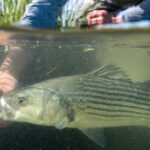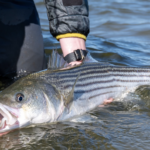
What to Watch for: ASMFC Spring Meeting
The Atlantic States Marine Fisheries Commission (ASFMC) will gather in Arlington, Virginia this week for the
By Tony Friedrich, Vice President and Policy Director
Photo Credit: Colin Cournoyer
After the last blog, we all know the issues with voluntary commercial transfers between the states. There are still the other issues from Amendment 7 that we need to tell you about.
If you recall the PID process, the only topics left on the table are conservation equivalency, release mortality, management triggers, and another entry from the meeting in May, protecting the 2015-year class. Let’s jump right into these.

Recreational Release Mortality

When you look at the options on the slide above, the first three appear extremely reasonable. Each item is something we can control, and the vast majority of striped bass anglers would embrace.
The fourth item seems to be something most would consider as well. Seasonal closures would make sense during spawning season or in geographic areas that experience extreme water temperatures in the summer.
However, when you see the details and understand what is really going on, it is much more difficult to support. Unfortunately, it seems the Commission can never do something that just makes sense. Instead, some managers always have to slide something in that clearly benefits one sector and hurts striped bass recovery.

There are no harvest and no targeting closures being considered. You can see there in black and white that MRIP cannot account for angler behavior and cannot separate catch and release (no harvest) from no targeting. How do you enforce no targeting? Law enforcement has repeatedly gone on record to say it is not enforceable. In the Chesapeake, you will catch striped bass when you are fishing for bluefish, Spanish mackerel, red drum, speckled trout, and white perch. What does a guide in the Chesapeake Bay do when these species are mixed in many locations? Does no targeting effectively close the charter industry down?
During the existing no targeting closures in Maryland and the Potomac River (PRFC), commercial fishermen can still fish. That means pound nets are in the water and hook and line is still in season. Effectively making the Maryland portion of the Chesapeake Bay off limits to recreational anglers while leaving it to the commercial sector with no competition. The hook and line and pound net seasons run from June 1 to December 31. During this time, 12% of striped bass captured in pound nets are 12”. Can you honestly suggest that all these 12” fish are released unharmed? How is this fair to the guide community in any way? This isn’t the same situation as the EEZ. It shuts down the fishery for only one sector.
None of this matters in Maryland. Much like the decision to cut the commercial quota by 1.8% instead of 18%, the current administration is one-sided. Over 60% of the commercial poundage of striped bass harvest comes from the Chesapeake. How much more do they want?
Please look at the graph below. You can see that the percentage of fish released since the late 1980’s has remained almost constant. There have been several changes in size and creel limit, yet around 90% of striped bass are released. This information does not make sense when you hear certain commissioners say that the size limits are the reason why so many striped bass are released. How could this possibly remain the same over the course of over 30 years if that was true? The short answer is that it can’t.

There are a few other tidbits of information one can glean from this chart. Catch and release mortality was much higher, almost twice as much, in 2006. Why wasn’t catch and release mortality such an important issue then? We can tell you. The stock was healthy and certain states weren’t looking for places to deflect the blame and continue unsustainable harvest. Our catch and release mortality is the same as 1996 levels. That makes sense because the stock is about at that same level. See the correlation? The number of striped bass in the system ultimately determine the amount of discard mortality, effort, etc. Essentially, this is primarily a catch and release fishery. It always has been.
Conservation Equivalency
Accountability has always been a huge issue with Conservation Equivalency (CE). MRIP complicates accountability on the back end. That is, if a state overfishes by way of CE, it becomes difficult to penalize them in the following year. That is the bad news.
The good news is that we can put guidelines on the front end. As an example, if a state decided to go with CE, they would have to “pay a premium”. Currently, any fisheries management plan must have at least a 50% chance of being successful. What if plans that use CE had to have a 75% or 100% chance of success? This would make the states pay it forward instead of taking a penalty after the damage is done. We will follow this issue closely because we could actually be able to place some guard rails on this highly abused practice.
Management Triggers
For reference, here are the five management triggers laid out in Amendment 6.
Amendment 6 also includes five “management triggers” that theoretically compel the Management Board to take corrective action should certain events occur.
1) If fishing mortality threshold is exceeded in any year, the Board must reduce the fishing mortality rate to a level that is at or below the target within one year.
2) If the female spawning stock biomass falls below the threshold in any given year, the Board must rebuild the biomass to the target level within no more than ten years.
3) if the fishing mortality target is exceeded in two consecutive years and the female spawning stock biomass falls below the target within either of those years, the board must reduce the fishing mortality rate to a level that is at or below the target within one year.
4) If female spawning stock biomass falls below the target for two consecutive years and the fishing mortality rate exceeds the target in either of those years, the board must rebuild the biomass to the target level within no more than 10 years.
5) If any juvenile abundance index (young of the year survey) shows recruitment failure (i.e., JAI is lower than 75% of all other values in the dataset) for three consecutive years, then the Management Board will review the cause of the recruitment failure (e.g. fishing mortality, environmental conditions, disease etc.) and determine the appropriate management action.
There has been a lot of talk about trigger number 5. We expect some movement, maybe positive, on this trigger. We are also watching triggers one through four as well. Why? Because there are short timelines associated with management action. Triggers one and two are one year. Triggers three and four are two years. Extending those timelines would be highly detrimental to striped bass recovery. We won’t know until the document comes out after the October meeting.
Protecting the 2015 Year Class
At the May ASMFC meeting, Commissioner Ware (ME), put forth the idea to protect the 2015-year class as it matriculated through the biomass. This is the same tactic used during the moratorium. We protected the last good year class. Doing this doubled the spawning stock biomass within ten years.
We were encouraged with this motion. However, we have heard little about it. In fact, during the August meeting, protecting the 2015-year class was discussed from the 3 hour, 11 minute, and 50 second mark to the 3 hour, 12 minute, and 26 second mark. That is right folks. A whopping 36 seconds was given to the only management action known to recover a decimated stock. Don’t believe us? Listen for yourself. You can’t make this stuff up.
Moving Forward
The draft of Amendment 7 will be available after the meeting in October. The hearing schedules will be published shortly thereafter. This is when we need all of you again. It has been a long fight but we are just getting started.

The Atlantic States Marine Fisheries Commission (ASFMC) will gather in Arlington, Virginia this week for the

Consistent spawning production is paramount to a fishery’s long-term health. Many environmental factors are suspected

While the ASGA team is extremely proud of the community we’re building with the Guide

Feature Image: A false albacore being landed off Jupiter Florida by the Cheeky Fishing team,
We rely on our members and donations to keep fighting for a sustainable tomorrow in marine conservation.
By using this website, you agree to our use of cookies. We use cookies to provide you with a great experience and to help our website run effectively. To learn more, please review our privacy policy.